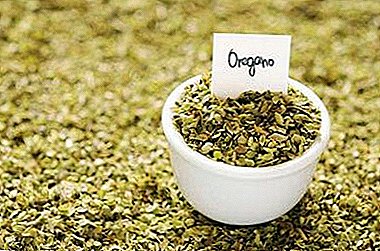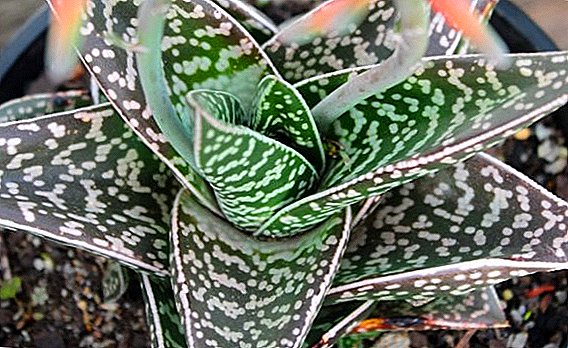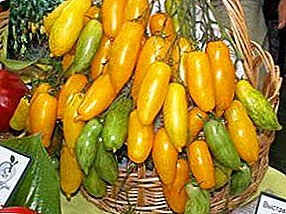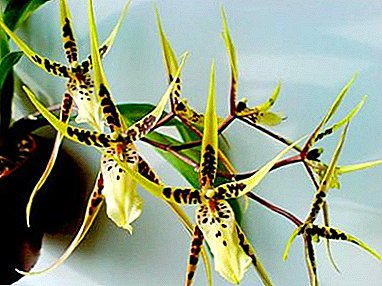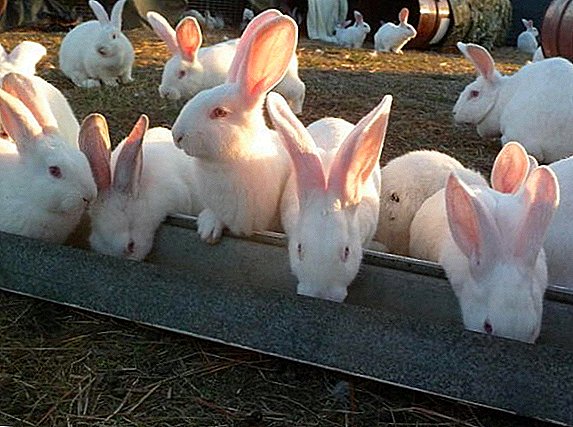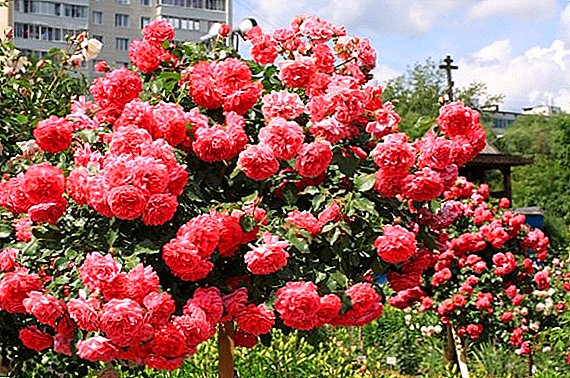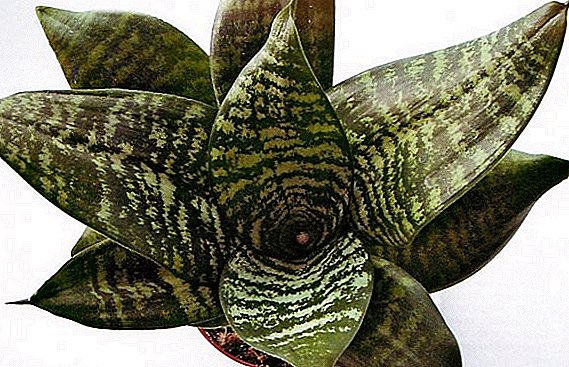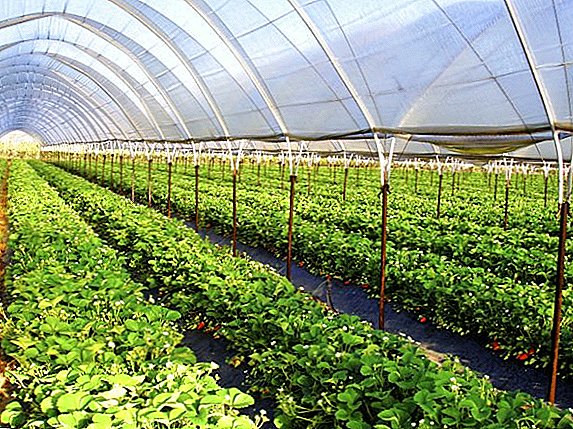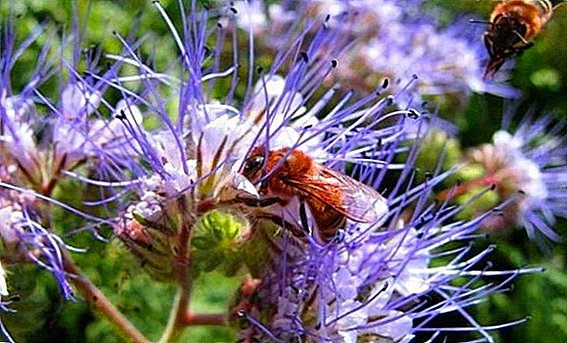 Phacelia - a useful and versatile plant. This is a rich melliferous plant, excellent food and the perfect form of green nitrogen fertilizer. Many gardeners show excessive interest in this plant and in every possible way look for information about the features of the “life of the nectar store”. Our article will reveal some secrets of planting, feeding, watering, growing and caring for phacelia, which will help everyone who wants to get the most out of this plant.
Phacelia - a useful and versatile plant. This is a rich melliferous plant, excellent food and the perfect form of green nitrogen fertilizer. Many gardeners show excessive interest in this plant and in every possible way look for information about the features of the “life of the nectar store”. Our article will reveal some secrets of planting, feeding, watering, growing and caring for phacelia, which will help everyone who wants to get the most out of this plant.
Botanical description
Phacelia - a multi-species representative of the hydrophilic family, that is, aquifers, which, according to various sources, has from 80 to 200 species.  The plant came to us from America and got accustomed to our territory. But, unfortunately, not all types of flower can grow with us. Only four varieties are in greatest demand, which will be discussed below.
The plant came to us from America and got accustomed to our territory. But, unfortunately, not all types of flower can grow with us. Only four varieties are in greatest demand, which will be discussed below.
You will be interested to learn about the beneficial properties of phacelia honey.Phacelia is grown from seeds, there are no restrictions as to when to plant them. Honey plant can reach from 20 cm to 1 m in height. At the beginning of the growing season, its stems are thin, fragile and juicy, and after - thicken and become hard.
Important! On each stalk of phacelia grows up to 20 side shoots with many-flowered inflorescences. One inflorescence can hold 20-40 flowers, and a whole plant up to a thousand. The period of flowering on the plantations ranges from 20 to 45 days: first, the flowers bloom below, and then gradually get to the top.Honey plant is easily recognizable by the blue-violet color of its flowers and the sweet aroma that instantly attracts bees. The duration of flowering of one nectar is about 3 days. After flowering, the plant mow and fertilize their soil.
 The main advantages of such a flower - it does not require special care, it is completely unpretentious to the conditions, it grows and spikes quickly, blooms almost all summer, which allows you to collect a huge portion of honey and at the same time fertilize the soil with useful trace elements.
The main advantages of such a flower - it does not require special care, it is completely unpretentious to the conditions, it grows and spikes quickly, blooms almost all summer, which allows you to collect a huge portion of honey and at the same time fertilize the soil with useful trace elements.Types for growing in the garden
Phacelia possesses not only honey-bearing and soil-friendly properties, it is an excellent decorative decoration for your garden that will help protect other plants from pests and diseases. Honey plant will decorate the garden and fill it with enchanting scents.
Not all types of phacelia are suitable for decorating a garden. For cultivation in the garden, we recommend choosing the following varieties:
- Bellied phacelia. In the photo, the phacelia of the bell-shaped one really resembles bells of a dark blue color, with a diameter of 2.5-3 mm. Plant height reaches 40 cm. Stems have a reddish color. June - the height of flowering of this species.
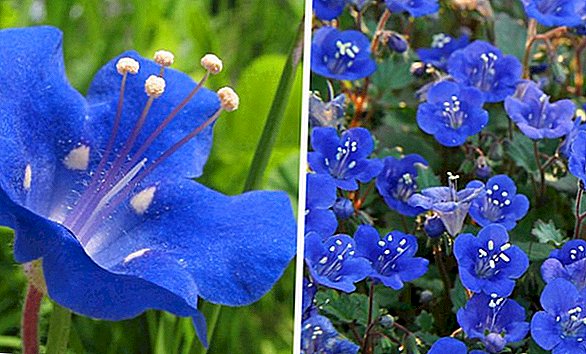
- In May, your garden will be decorated with flowers. phycelia. The inflorescences of this plant resemble spikes with pink-blue flowers with a diameter of 2 cm. The height of the stems of this species reaches 100 cm. Both the stems and its shoots are covered with villi.
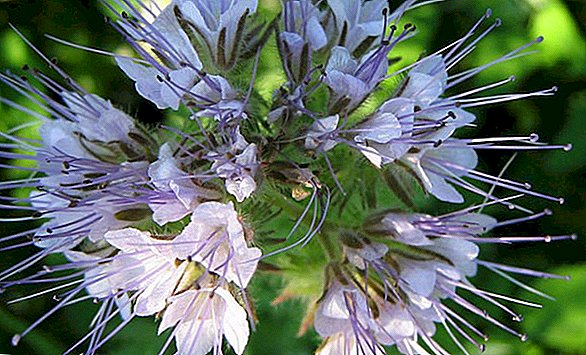
- Phacelia Purshawhich growth makes up to 50 cm. This look draws attention with an interesting color of flowers - their middle is white, and the edges are pale pink. But this is not the only combination. Pursha is the leader in color diversity.
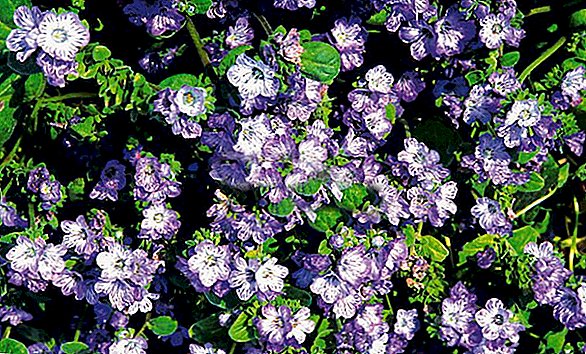
- Phacelia twisted got its name due to twisted inflorescences of bright blue or white flowers, whose diameter is 0.5 cm. The seed pods of this species are distinguished by their decorative properties.

Where to plant phacelia
Phacelia is a versatile flower for which there is no bad soil. The plant can be planted in any suitable place. The only condition is that when sowing the soil must be wet, otherwise the seeds may not germinate.  If you want to grow green manure in arid areas, you should carefully choose the land and choose the one that is protected from excessive drought by shelter belts or groves. In this case, the moisture will be stored and accumulated.
If you want to grow green manure in arid areas, you should carefully choose the land and choose the one that is protected from excessive drought by shelter belts or groves. In this case, the moisture will be stored and accumulated.
The following plants also belong to honey plants: bruise, cilantro, yellow and white acacia, sunflower, rape, linden, heather, snyat, oregano, melluna, cherry plum, pear, cherry, apple.
Lighting
Experienced gardeners are advised to plant the rows of honey from the north to the south, which contributes to good illumination of a flowering plant, direct sunlight. After all, flowers need enough light. With proper lighting, the plant will "thank" a lot of nectar.
Did you know?One hectare of flowering phacelia can collect a ton of honey: bees collect 5 times more nectar if they live next to a honey plant.
Soil type
Phacelia is unpretentious to earthen soil: it can be sown, both on wet and on arid or stony soils. But, as with any other plant, cultivated soil is best suited for cultivated soil enriched with nutrients.  In addition, the honey does not get along with the weeds, from which it must be constantly cleaned. Not advised to plant flowers on the slopes or arid and littered areas. Excess moisture can also adversely affect the vital activity of the siderata plant. An experienced gardener must fully comply with the measure.
In addition, the honey does not get along with the weeds, from which it must be constantly cleaned. Not advised to plant flowers on the slopes or arid and littered areas. Excess moisture can also adversely affect the vital activity of the siderata plant. An experienced gardener must fully comply with the measure.
Honey plant is able to independently form and structure the soil: its roots loosen and make even hard ground airy. Thanks to the siderat properties, other plants planted on the plot will “feel” excellent after them.
Honey Planting Rules
Consider how to plant phacelia in the spring.
Everyone who wants to benefit from the nectarose should consider the following:
- Treating the seeds of a future plant with herbicides before sowing can damage seedlings.
- On 1 hectare of the land plot it is advised to use 10-12 kg of seeds.
- On 1 sq. M. need from 8 to 10 g of seeds.
- When sowing, you need to keep a distance between rows of about 15 cm.
- Seeds need to be deepened into a moist soil by 1.5-3 cm.
- It is very important that the seeds are completely covered and protected from light. Otherwise, they will not ascend.
- Regarding the question of when it is necessary to sow nekaronos in the spring, there are no restrictions: you can sow immediately after the snow melts, it is possible in April or in May. The plant is cold-resistant and is not afraid of spring frosts. In arid areas, flowers should be sown in May.
- According to research, the highest quality seeds can be obtained in June, for this plant is recommended to sow in May, not later than the 25th.
- Those wishing to collect as much honey from inflorescences are advised to plant a honey plant near the hives.
Care features
It is positive that the plant is not picky: planting and caring for phacelia in open ground is not difficult.
You just need to remember that during the germination of the honey plant it is necessary to water it, because without water the seedlings of the plant will be very long. Medonos also can not be transplanted - he simply will not survive and die.
Thinning and soil care
After sprouting, planting of the nectar, it is necessary to thin out and also weed the crops and remove the weeds.  Gardeners are advised to do this in the first 2-3 weeks after sowing. Planting honey flowers in stony ground need additional loosening of the ground.
Gardeners are advised to do this in the first 2-3 weeks after sowing. Planting honey flowers in stony ground need additional loosening of the ground.
Watering and feeding
Experienced gardeners recommend moderately watering the crops of a honey flower and moisten the soil during germination, as the young plant needs water, otherwise it will not grow well.  Organic, phosphate and potash fertilizers should be chosen as a top-dressing, trace elements of boron and magnesium are suitable. It is recommended to fertilize the soil in the fall for plowing. On good soil, the honey plant feels great even without fertilizers.
Organic, phosphate and potash fertilizers should be chosen as a top-dressing, trace elements of boron and magnesium are suitable. It is recommended to fertilize the soil in the fall for plowing. On good soil, the honey plant feels great even without fertilizers.
How to collect phacelia seeds
In addition to the above, phacelia is also grown in order to collect high-quality seeds. To achieve this goal between the rows of landings, it is necessary to observe a distance of 45 cm.  Plants intended for the collection of seeds require additional care - they need to be weeded more often, since the phacelia seeds are difficult to clean from small weed seeds.
Plants intended for the collection of seeds require additional care - they need to be weeded more often, since the phacelia seeds are difficult to clean from small weed seeds.
Important! The collection of green manure seeds occurs after the lower part of the boxes with the curls of seeds become brown. You need to collect the seeds separately. Due to the fact that flowering occurs gradually (from the bottom up), for future sowing, only seeds from the lower part of the plant should be selected, as those on the top will not have time to reach.On large plantations, honey harvesting occurs with the help of combines. After the bevel, the collected mass is threshed, vented, dried and cleaned with special equipment. Drying humidity should be 14%. In small areas, the seeds of honey can be collected manually.
Phacelia as a siderata
Phacelia - one of the most affordable and effective sideratov (herbal fertilizers). The plant increases the acidity of the soil, has phytosanitary qualities, enriches the soil with nitrogen and loosens it.
Novice gardeners are often asked when to sow phacelia in the spring as a siderat. To obtain a green fertilizer from the honey plant it should be sown immediately after the snow melted. But it will be more effective to plant the plant at the end of the summer or in the fall, so that the winter seeds will lie in the ground. For example, collected all the crops - sow honey plant.
Mustard, rye and lupine are also used as a siderata.If you have areas with completely depleted soil, you need to sow the siderata seeds on them for the whole season. This way you fertilize the soil and let it rest - the organic matter will be fermented and enrich your site with useful nutrients.
In order to get as many useful microelements as possible, the siderata stems are advised to be cut off with the appearance of the first flowers, since after flowering its vitamin reserve will become poorer.
Did you know? Most siderats have related cultures and cannot be sown alternately. Such relatives are in nature beans with lupine, mustard with radish. Phacelia - the only siderats, which has no phytopatrials.Unnoticeable at first glance, the plant harbors many advantages. This is, firstly, the leader among honey plants: the nectariness of phacelia is 200-500 kg per hectare.
 Green mass is used as green fodder and silage. But dried plants for food will not work.
Green mass is used as green fodder and silage. But dried plants for food will not work.Phacelia is one of the most common and effective green fertilizers. It enriches the soil with many beneficial trace elements and increases productivity.
In addition, the honey flower is a beautiful decorative decoration of the garden or the dacha plot. Photos with phacelia during flowering will be your favorite family photos. This is something like lavender fields.







